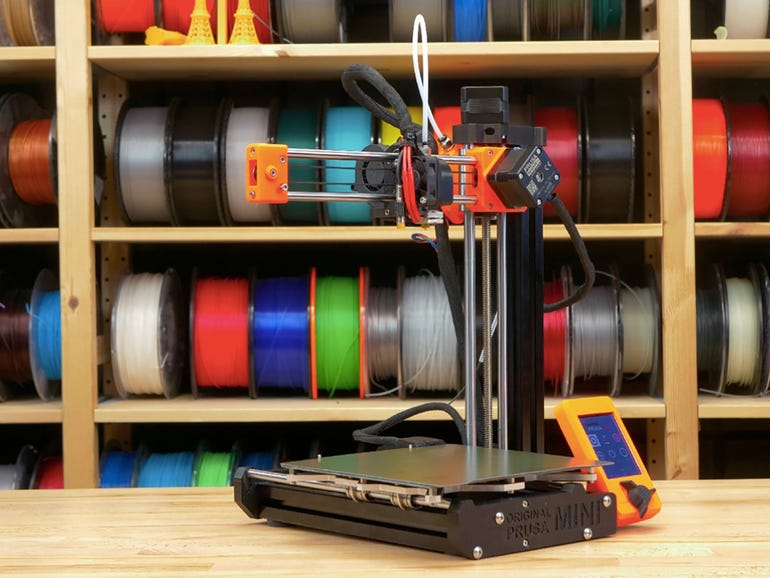Best cheap 3D printer 2022: Beginner picks under $500 | ZDNet
So, you want to get started with a 3D printer? Congratulations. It’s not an overstatement to say that 3D printing changed my life. It opened up the possibility of making custom physical objects to meet my own specific needs. It got me comfortable building in the workshop and helped me create solutions I use every day.
But getting started can be daunting. What printer should you get? How much should you spend? Should you get SLA (resin) or FDM (filament)? This article is designed to break through those questions.
Let’s start with the resin vs. filament discussion. I recommend resin printers to people who want to produce small items of fine detail. Miniature gamers are a massive market for these, as are model railroaders and modelers of all kinds. Print quality can be exceptional, but they create more mess, smell a bit more, and require careful post-processing and management of somewhat toxic liquids.
By contrast, I recommend filament printers to those who want to build objects that meet specific functional needs (rather than display needs). I use 3D printers for brackets, mountings, practical projects, and more. You can also make much larger objects with filament printers, so they’re a staple in the cosplay world for making masks and greeblies.
As for price, there are budget considerations. All the printers in this list are lower-cost printers. I have another list of pro-level printers you can check out if you’re able to spend more. Pro-level printers are more robust and — unfortunate for beginners on a budget — often have conveniences like automatic bed leveling that make them easier to use. That said, you can go very far with most of the printers listed here.
One final note before we kick off this list. I’ve added “Top Pick” indicators to the first few printers. These are the printers I’d feel immediately comfortable recommending to friends who ask about what printer to buy. They’re the “can’t go wrong” choices. That said, the rest of the list offers better prices or different options, so all on this best-of list are great contenders for newbie 3D printing practitioners.
Original Prusa MINI+
Top Pick | Filament | Assembled $399; Kit $349
Josef Průša is about as close to 3D printing royalty as anyone can get. We talk about his story more in our best 3D printers for pros guide, where we spotlight the $999 Original Prusa i3 MK3S+.
With a build volume of 180x180x180mm (about 7 inches), the MINI+ has a relatively small build volume, but it’s probably the most “pro” of the printers we’re spotlighting in this guide. It’s designed to be a workhorse in design shops and print farms, but at $399, it’s also accessible to hobbyists and first-timers. If you want a hassle-free experience, this may well be the printer to choose to begin your 3D printing journey.
Pros:
- Excellent quality
- Native Prusa slicer
- Mesh bed calibration
Cons:
- More costly than some competitors
- Not available from Amazon
- Small build volume
Elegoo Mars 3
Top Pick | Resin | $297
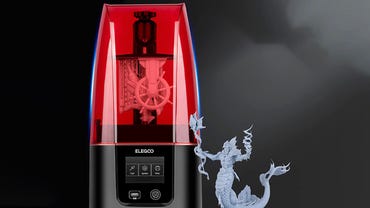
Resin printers are becoming enormously popular among 3D printing enthusiasts, especially those who want smaller prints with very high detail. The Mars 3 is actually the fourth small form-factor resin printer from Elegoo.
The Mars 3 uses a monochrome 4K LED light source, which means all the pixels of the 6.6-inch display activate to expose the print layer. This iteration adds a chip-on-board (COB) lens with a free-form surface, increasing the uniformity of UV light illumination. Additionally, the Mars 3 comes with a free one-year license to the Chitubox Pro slicer, although you can also use the Lychee slicer as well.
Be aware that the price and availability for this printer do fluctuate, so depending on when you look, the price could be higher, or you might need to wait for it to be back in stock.
Pros:
- High-resolution prints
- Monochrome display
- Uniform print quality across bed
Cons:
- Chitubox Pro is an extra cost license after one year
- Relatively small build area
- Supports can be a challenge
Also: Practical 3D prints: A first TinkerCAD project for your 3D printer
Anycubic Mono X
Top Pick | Resin | $449
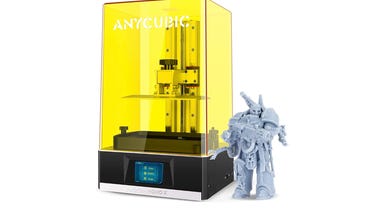
Objects solidify in resin printers when light hits the resin. Many printers use color LCD displays (essentially, cheap phone displays) to project the light. Recently, there’s been a surge in slightly more custom monochrome displays, which offer higher resolution and more clear light, resulting in faster, cleaner prints.
The Anycubic Mono X is one such printer, and it’s similar in display technology to the Mars 3 we just showcased. With an 8.9-inch 4K monochrome display, Mono X has a larger build area, allowing you to build bigger models. The Mono X also has an improved gantry for smoother prints and better support.
To be honest, we see Elegoo and Anycubic running neck-and-neck when it comes to quality printers. You’d have a great solution with either one, but the decision ultimately will come down to which features you want most and whether you want to use the Chitubox or Lychee slicer with the Elegoo or the Photon slicer with the Anycubic. Frankly, both companies have impressive offerings.
Pros:
- “Just right” build area fits many models
- Monochrome display
- Excellent resolution
Cons:
- Proprietary Photon slicer
- Sometimes difficult to get the exposure-to-weight ratio right
Elegoo Neptune 2
Top Pick | Filament | $199
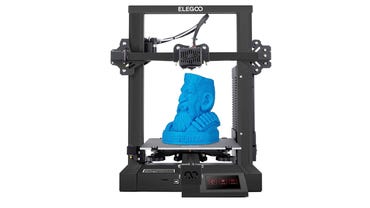
We (and pretty much half the world) are huge fans of the Creality Ender 3, which we profile next. But we have to replace the Ender 3’s Top Pick slot from our last update with the Elegoo Neptune 2, which is everything the Ender 3 is, but less expensive and with generally smoother prints.
For a budget printer with a 220x220x250mm build area, the machine has a few decidedly non-budget features. It has a filament run-out sensor, so you can replace the spool and keep on printing if you run out of filament. And it has a removable build plate, which makes removing prints much easier and more reliable. Overall, an excellent printer and a favorite for folks setting up small print farms with inexpensive printers.
Pros:
- Excellent price
- Filament run-out sensor
- Good print quality
Cons:
- Manual bed leveling
- Inconsistent availability
Also: Everything you need to know about 3D printing and its impact on your business
MINGDA Magician X
Filament | $399 from Amazon | $349 direct
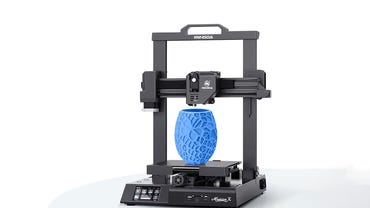
The MINGDA Magician X checks off a lot of the boxes for a filament 3D printer. It’s got a heated build plate, a direct-drive extruder (which makes flexible filaments print more reliably), a filament runout sensor, and it even sports automatic bed leveling. With a build area of 230x230x260mm, it can handle a wide range of mid-range sized prints.
Assembly was easy and straightforward. Print quality using PLA was quite good. I didn’t test with ABS (because I’m not a fan of the stank), but this printer is spec’d to be able to reach 260 degrees C at the hot end. Unfortunately, the hot end isn’t all metal, so you’re not popping above 300 degrees, which does limit some materials. We would have liked to see a removable build plate because some of those prints adhered to the bed like a puppy to mommy during a thunderstorm. Our suggestion is to use blue tape, so you can peel the tape up and free the prints. Overall, though, the MINGDA Magician X is a definite win.
If you buy directly from the company, you may be able to save a few bucks. As of the time of writing, the price of the device was $349 directly from the Mingda website and $399 from Amazon.
Pros:
- Direct-drive extruder
- Automatic bed leveling
- Easy to build
Cons:
- No removable build plate
- Prints are often very difficult to remove
Creality Ender 3 Pro
Filament | $239
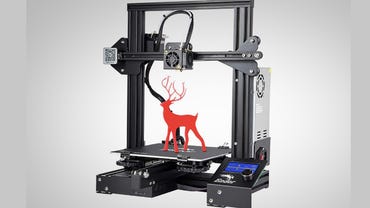
Creality has made a name for itself by selling low-cost 3D printers with reasonable build quality. You can get less-expensive printers with the same specs from other vendors, but generally speaking, Creality has managed to offer a consistent price/performance level, which is why we’re spotlighting two of the company’s printers on this list.
It features a removable build surface plate, can heat to 110 degrees C in just five minutes, and it comes with a 12-month warranty with lifetime technical assistance and 24-hour customer service.
You will need to allocate a few hours to build this printer. It does come with some sub-assemblies already put together, but some kit building is required. With a 220×220 build surface, there’s a heated bed that can improve adhesion. It uses a 1.75mm filament.
Pros:
- Enormous, vibrant aftermarket
- Lots of available customizations
- Hundreds of instructional videos and tips
Cons:
- Getting a little old
- No automatic bed leveling
JGMAKER Magic Upgraded 3D Printer
Filament | $199
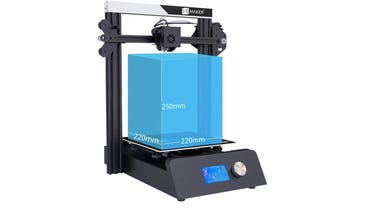
Now let’s switch to another $199 printer, this time with a larger 220 x 220 x 250mm build area. It has a heated bed, but it doesn’t have Wi-Fi. On the other hand, the device does have filament run-out protection, which (if nothing else goes wrong) will let you replace the filament if it runs out before the print completes. Be aware that there will be some assembly required for this printer. That said, who can turn down a “magic upgraded” printer, especially when that’s part of its name?
Pros:
- Low price
- Heated bed
- Filament run-out sensor
Cons:
- No Wi-Fi
- No automatic bed leveling
- Assembly can take time
Also: Practical 3D prints: Increasing workshop storage with bolt-in brackets
QIDI Technology X-one2
Filament | $279
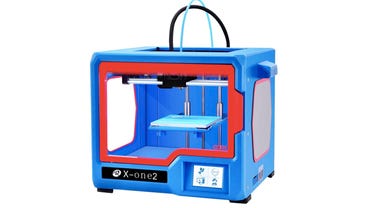
Interestingly, this seems to use the Ultimakers as inspiration. If you look at my Ultimaker 3 or Ultimaker S5 reviews, you’ll notice that this has the same bed lift mechanism and the same extruder carriage design. It’s also enclosed, which helps manage the heat dissipation and can result in nicer prints.
To be clear, the QIDI isn’t $3,000 or $6,000. At a mere 140 x 140 x 140mm build area, it’s a fraction of what the Ultimakers provide. It also doesn’t support dual filament printing and doesn’t provide automatic bed leveling, a camera, or internal lighting. That said, if you want to get a feel for how an enclosed printer might work and do it relatively inexpensively, the QIDI is worth a look.
Pros:
- Enclosed print area
- Extruder cartridges
Cons:
- Very tiny build area
- No automatic bed leveling
- Kind of expensive for what it does
Sovol SV02
Filament | Dual Extruder | $287
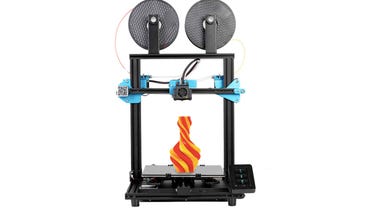
Last on our list is a special choice, the Sovol SV02, which is the only dual-extrusion printer on this list. Dual-extrusion printers allow you to load two filaments into the printer and switch between them mid-print. You can do this for two-tone highlighting or use one filament as the final object and one filament for supports. I use a dissolvable PVA support filament on the Ultimakers to create complex, intricate prints.
This printer stands out because the dual filament capability is in a $287 machine. It appears users either love it or hate it, which may go to the cost controls necessary to reach that price point with dual filament functionality. That said, I prefer dual filament machines, and if you’re willing to take a slight risk (Amazon does allow returns), it’s a worthwhile and powerful option.
Pros:
- Dual filament printing
- Exceptional price for dual filament printer
- It can be expanded with a laser engraving kit
Cons:
- Some users report unreliability
- Sometimes difficult to get dual printing to work
Also: Best 3D printer: FDM, resin, and more compared
EIBOS 3D Filament Dryer CYCLOPES
Filament dryer | $152
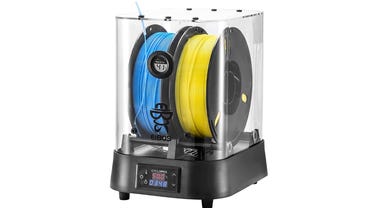
Since this is a cheap 3D printer article, we wanted to address one of the biggest cost items: the cost of filament. While you can get a 1kg roll of filament for as little as $18 or so, you can also find yourself spending $40, $60, or even $80 for a roll of a speciality filament. The problem is that filament is hydroscopic — it absorbs water in the air. Filament that’s not completely dry can clog your printer, leave artefacts on your print, and simply fail.
And sure, you can toss older, opened filament out when it gets too damp, but we recommend using a filament dryer like the EIBOS CYCLOPES. Just put a couple of rolls in the machine, turn it on, and it sucks out the dampness from your filament, often restoring the filament to new in a short time. It pays for itself if you can recover five or six rolls of otherwise useless filament.
Oh, and one more thing. You must watch the original EIBOS Kickstarter Video. Go. Do it now. Trust us when we tell you that Morgan the Cat steals the show. You can’t make this stuff up.
Pros:
- Can revive old filament
- Easy to use
- That Kickstarter video
Cons:
- Not all filament rolls can be saved
- Relatively large footprint
How did we choose these printers?
3D printers come on and off the market constantly. There’s almost always a bunch of Kickstarter campaigns for 3D printers with a slightly different set of specs or price points. But there are some machines that are classics. Those are machines I’ve worked with and have taken off in the hearts and minds of 3D printing enthusiasts. Those are the ones I labeled top picks.
Once you get under $400, though, especially down under $200, you wind up delving into the world of off-brands. These are quite competent printers but made by smaller or lesser-known companies. Here, I mostly relied on finding what was available and then cross-checking against formal reviews and user feedback. For those where I had any concerns at all (and when you get that cheap, you do), I flagged them in my listing.
What is the best 3D printer?
By now, you’ve probably figured out that there are a lot of differences between 3D printers, with a lot of different capabilities and functions. They’re also constantly evolving, so a printer that was at the top of its game last year may well be an also-ran this year. This article just covers 3D printers under $500. There are also more robust, faster, or more capable printers above $500. Those are spotlighted in our Best 3D printer 2022: FDM, resin, and more compared article.
In this article, we listed Top Picks. For under $500 filament printers, we like the Prusa and the Elegoo Neptune 2. For under $500 resin printers, you can’t go wrong with either the Elegoo Mars series or the Anycubic Mono X.
|
3D printer |
Type |
Capacity |
Features |
|
Original Prusa MINI+ |
Filament |
180x180x180mm |
Comes as kit or pre-assembled. Matrix bed calibration. |
|
Elegoo Mars 3 |
Resin |
6.6-inch display |
Monochrome display for faster printing |
|
Anycubic Mono X |
Resin |
8.9-inch display |
Big enough to print many models |
|
Elegoo Neptune 2 |
Filament |
220x220x250mm |
Very solid machine for a cheap price |
|
MINGDA Magician X |
Filament |
230x230x260mm |
Automatic bed leveling |
|
Creality Ender 3 Pro |
Filament |
220x220x250mm |
Incredibly popular. Huge aftermarket and userbase. |
|
JGMAKER Magic Upgraded 3D Printer |
Filament |
220x220x250mm |
Very inexpensive, filament run-out protection |
|
QIDI Technology X-one2 |
Filament |
140x140x140mm |
Tiny enclosed print area |
|
Sovol SV02 |
Filament |
280x240x300mm* |
Dual filament printer (*for one filament extrusion) |
How do I choose a 3D printer that’s right for me?
I recommend you make a few basic decisions. First, decide if you’re planning on making miniatures and tiny models. If so, then you want a resin printer. If not, you want a filament printer. Then, decide on how big the objects need to be. If you need very large prints, then your choices narrow quickly. Finally, decide on how much money you can spend.
Choose wisely. I do not necessarily recommend you go with the least expensive option because, at least for items on this list, those will be the printers that produce the lowest quality results along with the most frustrations. If you can afford it, you can’t lose by choosing any of my top picks.
Are 3D printers illegal?
Generally, no. I say “generally” because I’m not familiar with the laws of every country. Most don’t have much in the way of restrictions. There are some issues, though. For example, many countries (and even regions within countries) have rules about firearms manufacture and production. It’s likely that some aspect of making guns with 3D printers would be illegal. Generally, if you’re using a 3D printer to create something that you intend to use in an illegal activity, it’ll be illegal.
Are there alternative 3D printers to consider?
There are always alternative 3D printers to consider. There are a tremendous number of companies and models produced. Here are two I recently reviewed. Check them out:
Also: Anycubic Vyper: An under $500 filament printer with all the best features
Also: Biqu B1 3D printer review: Less than $300, some helpful features, but not perfect
Good luck, and let us know what you’re working on in the comments below.
You can follow my day-to-day project updates on social media. Be sure to follow me on Twitter at @DavidGewirtz, on Facebook at Facebook.com/DavidGewirtz, on Instagram at Instagram.com/DavidGewirtz, and on YouTube at YouTube.com/DavidGewirtzTV.
For all the latest Technology News Click Here
For the latest news and updates, follow us on Google News.

